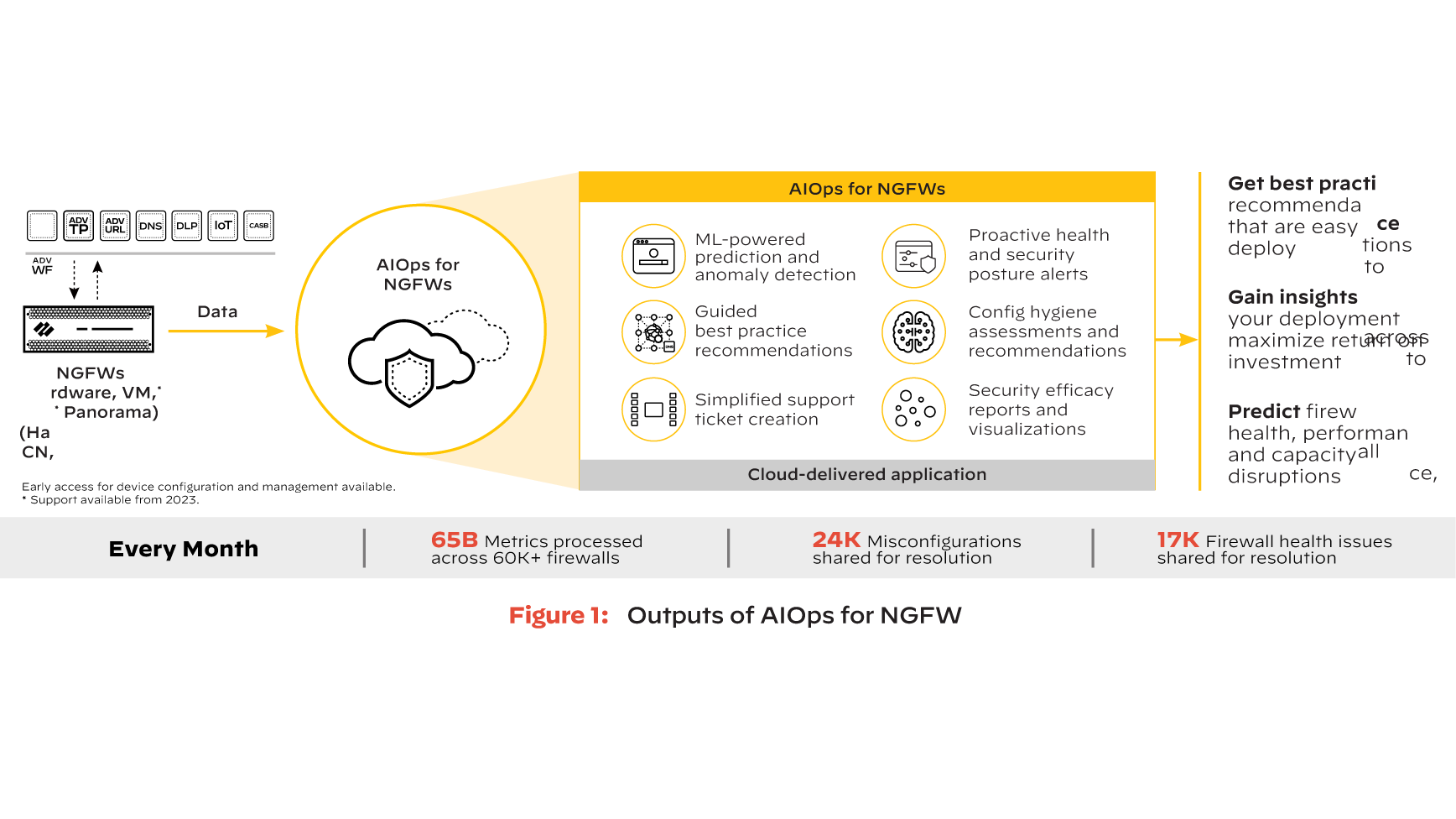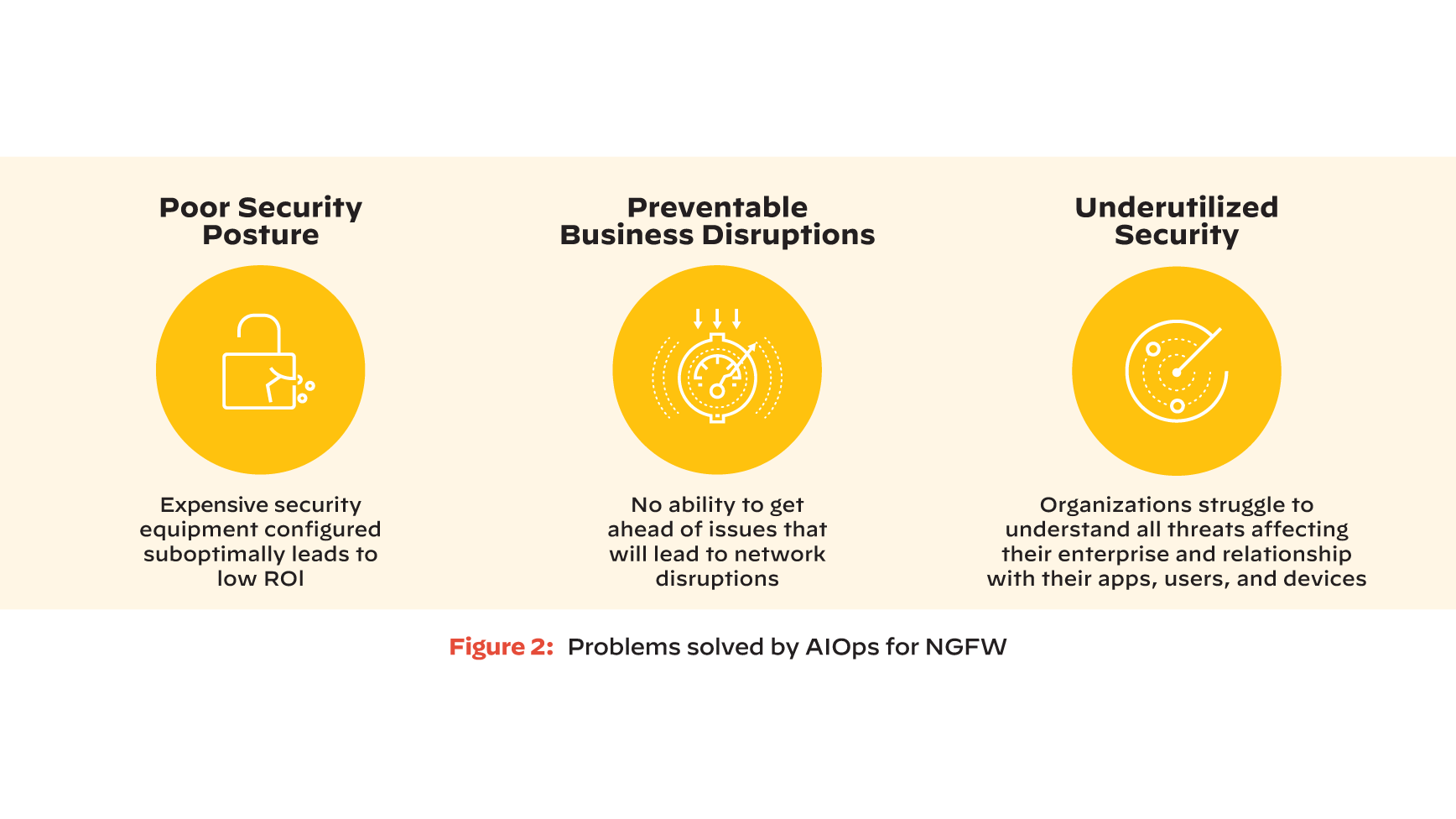What is AIOps for NGFW?
AIOps for NGFW enhances firewall operational experience with comprehensive visibility to elevate security posture and proactively maintain deployment health.
It enables security teams to continuously improve security posture by optimizing configuration to their dynamic environment based on best practices and configuration recommendations. AIOps for NGFW also empowers network security operations teams to become proactive with ML-powered anomaly detection and actionable insights into the health and performance of the entire deployment.
AIOps for NGFW proactively addresses the top operational challenges of today, including:
- Misconfigurations
- Human errors
- Compliance with best practices
- Resource usage
- Flood detection
- Hardware and software failures, and more.
What Is AIOps?
Artificial intelligence for IT operations (AIOps) refers to platforms that leverage machine learning (ML) and analytics to automate IT operations.
AIOps harnesses big data from operational appliances and uses it to detect and respond to issues instantaneously. It replaces separate, manual IT operations tools with a single, intelligent, automated platform. This enables ITOps teams to respond quickly and proactively to slowdowns and outages with less effort.
AI features in AIOps today are primarily found within the operational health problem scenarios in the form of anomaly detection, forecasting, threshold, and state-change based alerts.
How Does AIOps for NGFW Work?
AIOps for NGFW relies on telemetry data from hardware firewalls, software firewalls and related management platforms.
The data moves to an AIOps environment, where machine learning algorithms are applied to produce recommendations and detect anomalies. It is typically easy to deploy and doesn’t require additional hardware or software to install.

Why Is AIOps for NGFW Necessary?
As enterprises expand and the threat landscape evolves, security teams invest in new and expensive network security equipment and tools to support their growing infrastructure and prevent threats to organizations.
However, network operations are complex, and organizations across industries struggle to fully utilize their network security infrastructure. Security teams don’t always know best practices for configuring various features to maximize functionalities or even have insights into misconfigurations. This leads to gaps in security postures and increases the risk of a breach. According to Gartner, misconfigurations will cause 99% of all firewall breaches through 2023.
Additionally, chaos ensues when one of countless security tools runs out of capacity due to a high processing activity or system-related factors (like hardware failures, software defects or licensing issues). This can delay or shut down the network, causing the loss of several thousand or millions of dollars. The average hourly cost of enterprise server downtime worldwide is US$300,000–$400,000,2 and an average cost of a data center outage is US$740,357.
Network operations teams often lack the visibility and product knowledge to prevent business-disrupting incidents due to firewall-related errors. Once impacted, they spend immense time and resources reacting to the situation and trying to determine the root cause — and while under tremendous pressure to bring the business back online.
To be efficient in managing firewalls and prevent business-disrupting incidents due to security gaps and firewall-related errors, network security operators need insights in advance, before they impact business.

Benefits of AIOps for NGFW
Organizations stand to enjoy a great deal of benefits when adopting this innovative technology.
Security Benefits
Following are the most impactful benefits of adopting of AIOps for NGFW to improve operational efficiency.
Proactively Strengthening Security Posture
AIOps for NGFW reduces the attack surface and strengthens security posture with the analysis of the configuration for best practices, combined with policy recommendations customized to unique deployments.
Best practice assessment recommendations are powered by machine learning (ML) based on industry standards, security policy context and advanced telemetry data. AIOps enables users to proactively recognize inefficiencies in a policy set before committing, rather than remediating after the change has been pushed to firewalls. This prevents weakening the security posture and saves time.
Proactively Resolving Firewall Disruptions
AIOps for NGFW also allows security operations teams to gain insights across network environments and reduce NGFW downtime with proactive insights. This maintains optimal firewall health and performance and keeps NGFWs running smoothly.
Achieving a Unified View into Security Effectiveness
Understanding which threats have been prevented across the infrastructure and which ones need attention becomes easily achievable with AIOps for NGFW.
AIOps leverages shared network and threat intelligence to automatically detect and understand a threat's trend to the enterprise and provides actionable remediations. This allows security admins to take immediate policy-based actions and stop emerging security risks.
Business Benefits
- Maximum security
AIOps continuously recommends best practices to improve overall security. - Minimum downtime
Preventable disruptions can be avoided and downtime reduced by predicting disruptions to NGFWs before they impact the business. - Gain confidence
Proactive insights make it easy to assess network health and security, bringing confidence in the stability of the network. - Maintain compliance
AIOps for NGFW solutions allow continuous assessments of security posture to maintain compliance with industry best practices. - Adopt features with best practices
Get guidance on adoption of firewall and security capabilities. - Save time
AIOps for NGFW capabilities reduces time to detect network security gaps significantly. - Unified visibility
Get a 360-degree view into the activity seen in the organization across applications, threats, networks, users and security subscriptions. - Higher return on investment
Save tens of thousands of dollars by automatically detecting security gaps in the network.
Learn More About Preventing Firewall Disruptions with AIOps for NGFW
Did you know that organizations with hybrid networks, remote users and tangled applications can cause network security operations to degrade security posture and lead to network shutdowns, costing millions of dollars in losses?
Read this e-book to learn how to strengthen your network security with AIOps: Get Smart with AIOps for Next-Generation Firewalls.
- Rajpreet Kaur, Adam Hils, and John Watts, Technology Insight for Network Security Policy Management, Gartner, February 21, 2019,
https://www.gartner.com/en/documents/3902564/technology-insight-for-network-security-policy-managemen. - Thomas Alsop, “Average cost per hour of enterprise server downtime worldwide in 2019,” Statistica, December 7, 2020,
https://www.statista.com/statistics/753938/worldwide-enterprise-server-hourly-downtime-cost/. - Cost of Data Center Outages, Ponemon Institute, January 2016, https://www.vertiv.com/globalassets/documents/reports/2016-cost-of-data-center-outages-11-11_51190_1.pdf.
AIOps for NGFW FAQs
AIOps stands for “artificial intelligence for IT operations.” It refers to platforms that leverage machine learning (ML) and analytics to automate IT operations.
AIOps harnesses big data from operational appliances and has the unique ability to detect and respond to issues instantaneously. Using the power of ML, AIOps strategizes using the various forms of data it compiles to yield automated insights that work to refine and iterate continually. AIOps seeks to address a quickly evolving IT landscape using the convenience of machine learning, automation and big data.